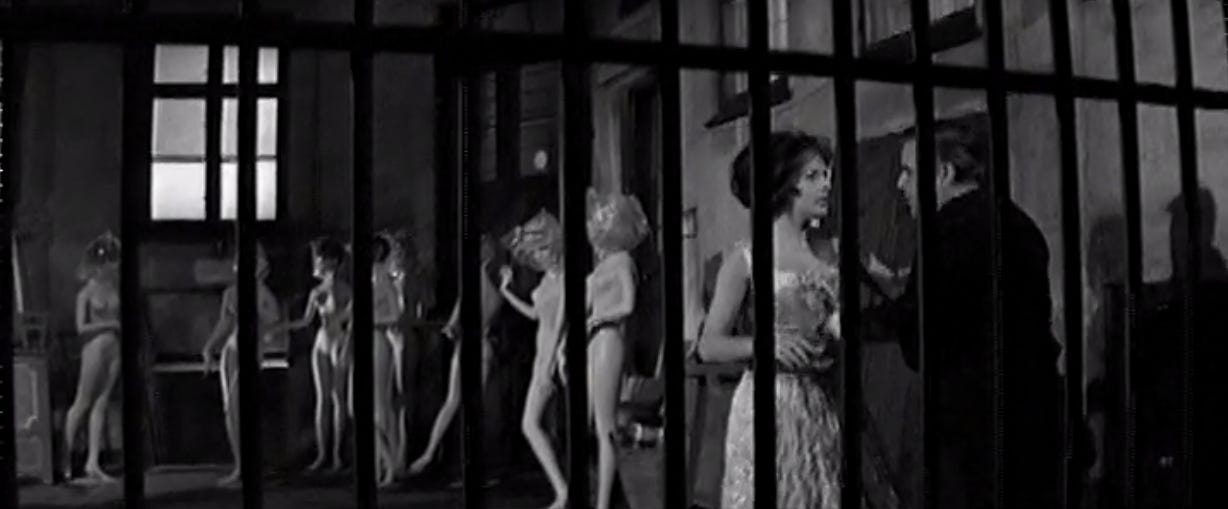Six years ago I co-wrote a short-lived but mighty column for Diabolique Magazine about the German krimi cycle, called Smooth Kriminals. My co-columnist Samm Deighan published some well-researched pieces, and my approach to it was more one of curious discovery. Not much had been written in English about the krimi, and I approached the films from the background I already had, with knowledge of gothic and noir tropes, German cinema history, and the Italian giallo. Smooth Kriminals fizzled out for various reasons, but I was left feeling like I needed to return to the krimi at some point with a more experienced and wiser perspective. The final film I wrote about--in a piece that was never completed--was Harald Reinl’s Room 13 (1964), which continued the genre formula, while also adding elements that could take the cycle in new directions.
A Franco-German co-production shot in Denmark, Room 13 is a movie full of striking visuals and disparate plotlines. We have a straight-razor-wielding serial killer on the loose, a criminal gang planning a train robbery, and a determined woman named Denise (Karin Dor) who is just trying to survive. By the end of the movie, these elements connect together in a head-scratching conclusion vaguely reminiscent of the schizophrenic reveal in Hitchcock’s Psycho (1960). A conventional critical view might consider Room 13 to be rushed and sloppily written, but it is just this kind of brash showmanship--as if the filmmakers are just daring us to go along with the rollercoaster shoved in front of us--that makes the krimi cycle so enjoyable.
Joachim Fuchsberger, one of the most enduring krimi leads, is back in one of his smarmiest and pushy renditions of Detective Johnny Gray. His smarm is compounded by an increase of women’s bodies on display in various cabaret scenes, although the skimpy performance lingerie is still quite chaste in relation to the frenzy of sexual violence to enter the cycle by the end of the decade. This fusion of sex and violence is still very much felt, as we see a striptease dancer murdered literally one step after she exits the stage. Room 13 seems to be aware of its objectification of women, and comments on this in humorous ways, in particular the supporting role of Dr Higgins (Eddie Arent). Higgins has a mannequin girlfriend named Emily, and tends to find himself infatuated with representations of women, as opposed to women themselves. His investigations involve examining women’s toes and footwear with an oversized magnifying glass, and finding that the murdered undercover policewoman was wearing “the official underwear of Scotland Yard.”
This preoccupation with perversion and sadomasochistic tendencies found in Room 13 is very much a reaction to and precursor of gialli which were also formulating at the same time in Italy. The menacing humor of the movie is highly similar to Mario Bava’s The Girl who Knew Too Much, released a year earlier in 1963. The more particular similarities occur in Bava’s next movie Blood and Black Lace (1964), released the same year as Room 13. The abundance of mannequins in the German movie is used more intentionally in the Italian film, which takes place in a haute couture fashion house. Like in many krimis, Denise’s room at the High and Low nightclub is illuminated by a flashing light right outside the window. We see this same effect in the creepy antique store that becomes a crime scene in Blood and Black Lace. Nicholas Schlegel takes note of the similarities between these two films in his book German Popular Cinema and The Rialto Krimi Phenomenon: “The Expressionist signatures that mark the Wallace Krimi, principally the chiaroscuro lighting, camerawork, and set design, had only been created for the abstract, chromatic universe of black and white cinematography. Bava, in contrast, detonated an effulgent big bang all his own resulting in the new color universe of the giallo. This proved to be a huge evolutionary step for Italy, but also for Germany.” (112) Indeed, the main difference between Room 13 and Blood and Black Lace is that the latter movie presents a world saturated by color, which would become a defining characteristic for the giallo, as well as a step forward for many krimis of the mid to late 1960s.
Keep reading with a 7-day free trial
Subscribe to The Left-Hand Path to keep reading this post and get 7 days of free access to the full post archives.



